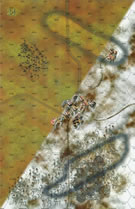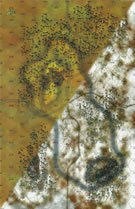|
Drunken Elephants: Bure, Belgium Britain's Bulge #7 |
||
|---|---|---|
| (Attacker) Britain | vs | Germany (Defender) |
| Formations Involved |
|---|

| Total | |
|---|---|
| Side 1 | 0 |
| Draw | 0 |
| Side 2 | 1 |
| Overall Rating, 1 vote |
|---|
|
4
|
| Scenario Rank: --- of 913 |
| Parent Game | Britain's Bulge |
|---|---|
| Historicity | Historical |
| Date | 1945-01-05 |
| Start Time | 09:00 |
| Turn Count | 24 |
| Visibility | Day |
| Counters | 41 |
| Net Morale | 0 |
| Net Initiative | 1 |
| Maps | 2: 24, 25 |
| Layout Dimensions | 56 x 43 cm 22 x 17 in |
| Play Bounty | 171 |
| AAR Bounty | 227 |
| Total Plays | 1 |
| Total AARs | 0 |
| Battle Types |
|---|
| Exit the Battle Area |
| Urban Assault |
| Conditions |
|---|
| Minefields |
| Off-board Artillery |
| Severe Weather |
| Scenario Requirements & Playability | |
|---|---|
| Britain's Bulge | Base Game |
| Elsenborn Ridge | Maps + Counters |
| Liberation 1944 | Counters |
| Introduction |
|---|
|
The town of Bure had been converted into a heap of rubble, but the Germans still clung to the houses and ruins, hidden in cellars and catacombs, fighting and sniping to the end. Their tanks still operated in the village which made mopping up by the British extremely difficult. On the previous evening, C Company of 2nd Battalion, Oxfordshire and Buckinghamshire Light Infantry, part of the 6th Airlanding Brigade, reinforced the 13th Parachute Battalion. On the morning of 5 January, the British assault was renewed. |
| Conclusion |
|---|
|
By 1015 a troop of 2nd Fife & Forfar Yeomanry had managed to work its way forward from Chapel Hill into a position where it could shoot at anything moving into or out of Bure’s eastern side. In the village, the British attack succeeded in pushing the bulk of the Germans out of the town although one tank remained despite repeated PIAT attacks against it. West of Bure, the 23rd Hussars’ tanks were due to relieve the Fifes during the day and join the fight. At 1000, A Squadron moved out from Tellin. “The roads were getting into an appalling state,” Lt. Edward Harte wrote later, “and our awkward, top-heavy Shermans skated about on the icy roads like a stampede of drunken elephants.” Bure lies at the foot of a high hill to the south of it, steep, wooded, covered in snow and half shrouded in mist. Most of A Squadron’s tanks set out to reconnoiter this high ground in order to cover the right flank of the infantry in the village. Slowly climbing out of Tellin up a steep and narrow track covered with ice, the tanks attempted to reach the crest. Visibility was barely thirty yards and the progress murderously slow. Behind them, the Germans had laid an ambush. Taking advantage of the mist and snow and woods, the Germans had concealed a party and a minefield across the track. One tank went up on a mine and another one was destroyed by panzerfausts. Tanks were not made to fight blindly in fog, up icy mountain tracks, and it soon became obvious that the whole enterprise was doomed, if not to disaster, at least to failure. By early afternoon the tanks withdrew and abandoned that part of the attack. Meanwhile, 1st Tank Troop fought its way through Bure where the Fifes and the infantry had already cleared the larger part of the village at great cost to themselves. But German outposts still clung to the eastern edge of the village and some of the remaining ruins. By 2100 the last German outpost had been eliminated by A Company and German resistance ceased. The British also made good progress towards the river at Grupont, where the two leading tanks were hit and destroyed. That evening, as 53rd Welsh Division on the left had met some success, XXX Corps ordered 6th Airborne Division to withdraw from Bure and extend its frontage in a defensive rather than an offensive role. The withdrawal was carried out during the night, without incident. In the fight to capture Bure and the surrounding villages, 13th (Lancashire) Parachute Battalion lost about a third its strength: seven officers and 182 enlisted (68 killed in action). The 2nd Battalion, Ox and Bucks, lost one officer and 20 enlisted (seven KIA). The Fife and Forfar Yeomanry and 23rd Hussars also suffered heavy casualties including the loss of sixteen Sherman tanks. The Belgian SAS lost three men while supporting the attack on Bure. |
| AFV Rules Pertaining to this Scenario's Order of Battle |
|---|
|
| 2 Errata Items | |
|---|---|

|
The "Optional Values" for the Firefly given in an Avalanche Press Daily Content piece on the 17-Pdr Anti-Tank gun (and printed on a replacement counter sheet Download) are now the Official Ratings, published in games like Cassino '44, Grossdeutschland 1946, and Indian Unity. These are: 5-5 / 8-8 Full Strength and 3-5 / 8-8 Reduced Strength. (caryn
on 2012 May 03)
|

|
The reduced direct fire value of the Heer HMG became 5-5 starting with Fall of France. (plloyd1010
on 2015 Jul 31)
|

 BBoB006
BBoB006 




















